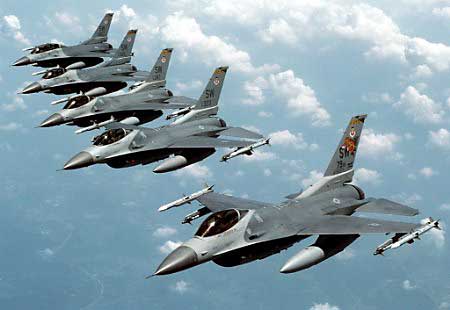After 17 months of silence, the 33rd Fighter Wing flightline here finally roared back to life Jan. 13.
The 33rd FW received four F-16 Fighting Falcons from the 56th FW at Luke AFB, Ariz. The jets will help establish a "battle rhythm," as the wing stands up the first joint training center for the fifth generation F-35 Joint Strike Fighter.
"Everybody who operates on this base will benefit from an airplane taxiing out of here," said Col. James Ravella, the 33rd Operations Group commander, "and outside the base, from Tyndall AFB to Pensacola Naval Air Station and other divert bases will get used to us coming over there."



Officials elected to bring the F-16 to the wing because of its similarity to its descendant, the F-35. Its flying characteristics are similar to the F-35 so the training and mindset pilots are going to have in a single-engine fighter transitions from the F-16 into the F-35.
The initial cadre of F-35 instructor pilots will fly the F-16s for about one year to validate processes and warm up the ramp, which has not been used to fly an aircraft since the wing transitioned to Air Education and Training Command in October 2009. Officials from AETC, Eglin and Luke worked to bring the F-16s to Eglin for more than a year.
"You are driving down risk by the type of aircraft, the type of flying we are going to be doing and just establishing a battle rhythm at the 33rd FW with the integration of Team Eglin," said Navy Capt. Michael Saunders, the 33rd OG deputy commander.
Eglin members play multiple roles in the success of the 33rd FW training mission, and the addition of these four aircraft will rekindle those partnerships, Colonel Ravella said.
"It exercises the whole 33rd FW as well as our coordination with the 96th Air Base Wing for its support and the 46th Test Wing where we coordinate air space and scheduling," he said. "We can't fly without linking into the 46th Test Wing or the 96th Air Base Wing. Those are the same relationships we are going to exercise when we fly the F-35."
The benefits of the F-16s already have been evident, even prior to their arrival. Wing personnel began testing hardware like hotlines that had not been in service in the 17 months since the last F-15 Eagle left the base.
Wing officials are producing the template for F-35 pilot and maintainer training, a model which will be applied across the spectrum of fighter operations for the foreseeable future. Those processes will be fielded on those four initial aircraft.
"This program is too important to the future of our nation to leave to conceptual planning. We need to test our processes with real iron, actual aircraft," Captain Saunders said. "It is one of those things that is going to help us root out the processes and identify seams or rough spots before we start up F-35 training here. This is a critical piece of that."
In addition to the aircraft, about 50 maintainers from Luke will stay to work on the aircraft during the year, said Capt. Timothy Plante, 62nd Fighter Squadron Aircraft Maintenance Unit officer in charge.
An advanced team of 10 already has received seven 40-foot trucks full of equipment.
"We got all our parts and equipment to fly these airplanes," the captain said. "It is just one step closer to the stand up of the F-35."
The board-selected pilots from three services have flown a diverse group of aircraft from F-15s to Harriers. The group, including Sailors and Marines, will fly with a common base thanks to the F-16.
"It is a joint effort," Colonel Ravella said. "Eventually, the Marine pilots that will transition to the F-35 will also fly the F-16. The Air-force provided hardware for the joint solution for the wing."
The 33rd FW re-designated under AETC on Oct. 1, 2009. The joint wing is responsible for F-35 A/B/C pilot and maintainer training for the Marine Corps, the Navy and the Air Force. In the future, for 59 aircraft there will be three flying squadrons, one for each service/aircraft variant, established.
"It is a part of a continuing process," Colonel Ravella said. "Bringing an airplane in here is huge step; it is a visual step that the 33rd FW is restarting flying operations."



0 comments:
Post a Comment